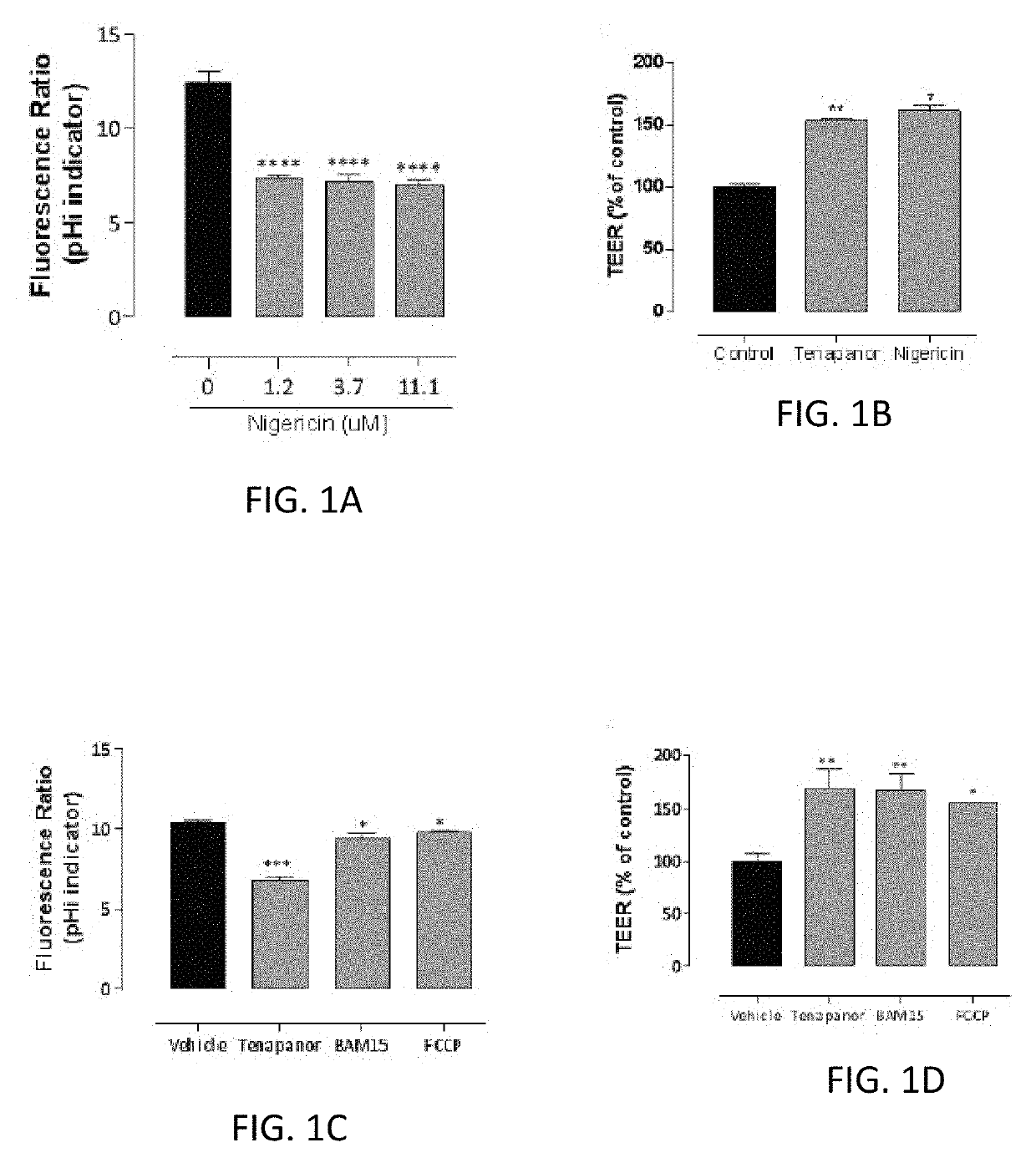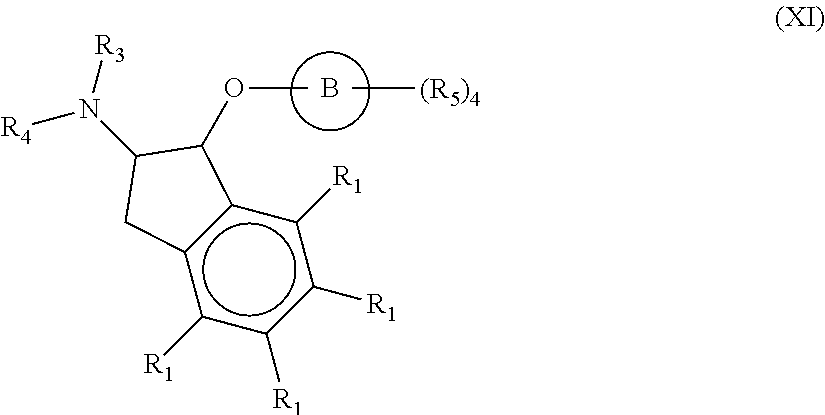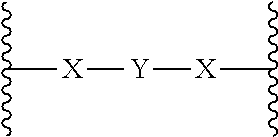Compounds and methods for inhibiting NHE-mediated antiport in the treatment of disorders associated with fluid retention or salt overload and gastrointestinal tract disorders
a technology of gastrointestinal tract disorders and compounds, which is applied in the direction of amide active ingredients, heterocyclic compound active ingredients, halogenated hydrocarbon active ingredients, etc., can solve the problems of fluid entering the lungs and congestive symptoms, filling pressure may eventually increase, and shortening of breath, so as to reduce inflammation of the gastrointestinal tract, treat or reduce pain, and reduce visceral hypersensitivity
- Summary
- Abstract
- Description
- Claims
- Application Information
AI Technical Summary
Benefits of technology
Problems solved by technology
Method used
Image
Examples
example 1
[0390](S,S)—N,N′-(10,17-dioxo-3,6,21,24-tetraoxa-9,11,16,18-tetraazahexacosane-1,26-diyl)bis(4-((1S,2S)-4,6-dichloro-2-(dimethylamino)-2,3-dihydro-1H-inden-1-yloxy)benzenesulfonamide): 1,4-Diisocyanatobutane (5.6 mg, 0.040 mmol) was added to a solution of N-(2-(2-(2-aminoethoxy)ethoxy)ethyl)-4-((1S,2S)-4,6-dichloro-2-(dimethylamino)-2,3-dihydro-1H-inden-1-yloxy)benzenesulfonamide (43 mg, 0.080 mmol) in DMF (0.80 mL). After 3 hours, the reaction mixture was concentrated under vacuum and purified by reverse phase HPLC (ACN / water / 0.1% TFA) to give a TFA salt of the title compound (44 mg). 1H-NMR (400 MHz, CD3OD): δ 7.91 (d, J=9.0 Hz, 4H), 7.51 (d, J=1.4 Hz, 2H), 7.35 (d, J=9.0 Hz, 4H), 7.10 (d, J=1 Hz, 2H), 6.45 (d, J=6.6 Hz), 4.41 (dd, J1,2=15.5 Hz, J1,3=8.6 Hz, 2H), 6.65 (dd, J1,2=16.7 Hz, J1,3=8.7 Hz, 2H), 3.57-3.50 (m, 8H), 3.48 (t, J=5.3 Hz, 8H), 3.27-3.19 (m, 6H), 3.07 (m, 8H), 3.02 (s, 12H), 1.44 (m, 4H). MS (m / z): 1203.0 (M+H)+.
Example 2
(S,S)—N,N′-(2,2′-(2,2′-(2,2′-(1,4-phenyle...
example 2
[0392](S,S)—N,N′-(2,2′-(2,2′-(2,2′-(1,4-phenylenebis(azanediyl))bis(oxomethylene)bis(azanediyl)bis(ethane-2,1-diyl))bis(oxy)bis(ethane-2,1-diyl))bis(oxy)bis(ethane-2,1-diyl))bis(4-((1S,2S)-2-(piperidin-1-yl)-2,3-dihydro-1H-inden-1-yloxy)benzenesulfonamide): 1,4-Diisocyanatobenzene (5.9 mg, 0.037 mmol) was added to a solution of N-(2-(2-(2-aminoethoxy)ethoxy)ethyl)-4-((1S,2S)-2-(piperidin-1-yl)-2,3-dihydro-1H-inden-1-yloxy)benzenesulfonamide (39 mg, 0.073 mmol) in DMF (0.40 mL). After 40 minutes, the reaction mixture was concentrated under vacuum and purified by reverse phase HPLC (ACN / water / 0.1% TFA) to give a TFA salt of the title compound (29 mg). 1H NMR (400 MHz, CD3OD) δ 7.87 (d, J=8.4 Hz, 2H), 7.44-7.32 (m, 3H), 7.29 (d, J=8.7 Hz, 2H), 7.26-7.12 (m, 5H), 6.34 (d, J=6.3 Hz, 1H), 4.26 (dd, J=15.0, 8.2 Hz, 2H), 3.67-3.57 (m, 10H), 3.57-3.49 (m, 6H), 3.46 (t, J=5.4 Hz, 4H), 3.33 (t, J=5.2 Hz, 3H), 3.26-3.17 (m, 2H), 3.16-3.09 (m, 2H), 3.05 (t, J=5.4 Hz, 3H), 2.04-1.64 (m, 7H), 1.53...
example 3
[0394](S,S,R)—N,N′-(10,17-dioxo-3,6,21,24-tetraoxa-9,11,16,18-tetraazahexacosane-1,26-diyl)bis(4-((1S,2S)-2-((R)-3-aminopiperidin-1-yl)-4,6-dichloro-2,3-dihydro-1H-inden-1-yloxy)benzenesulfonamide): 1,4-Diisocyanatobutane (6.7 mg, 0.048 mmol) was added to a solution of tert-butyl (R)-1-((1S,2S)-1-(4-(N-(2-(2-(2-aminoethoxy)ethoxy)ethyl)sulfamoyl)phenoxy)-4,6-dichloro-2,3-dihydro-1H-inden-2-yl)piperidin-3-ylcarbamate (66 mg, 0.096 mmol) in DMF (0.90 mL). After 30 minutes, the solvent was concentrated under vacuum. The residue was dissolved in DCM (0.5 mL) and TFA (0.5 mL) was added. After 30 minutes, the solvents were removed under reduced pressure and the residue was purified by reverse phase HPLC (ACN / water / 0.1% TFA) to give a TFA salt of the title compound (55 mg). 1H-NMR (400 MHz, CD3OD): δ 7.86 (d, J=9.0 Hz, 4H), 7.42 (d, J=1.8 Hz, 2H), 7.29 (d, J=9.0 Hz, 4H), 7.12 (d, J=1.2 Hz, 2H), 6.12 (d, J=5.7 Hz), 3.80 (dd, J1,2=13.5 Hz, J1,3=7.6 Hz, 2H), 3.57-3.51 (m, 8H), 3.48 (t, J=5.7 ...
PUM
 Login to View More
Login to View More Abstract
Description
Claims
Application Information
 Login to View More
Login to View More - R&D
- Intellectual Property
- Life Sciences
- Materials
- Tech Scout
- Unparalleled Data Quality
- Higher Quality Content
- 60% Fewer Hallucinations
Browse by: Latest US Patents, China's latest patents, Technical Efficacy Thesaurus, Application Domain, Technology Topic, Popular Technical Reports.
© 2025 PatSnap. All rights reserved.Legal|Privacy policy|Modern Slavery Act Transparency Statement|Sitemap|About US| Contact US: help@patsnap.com



